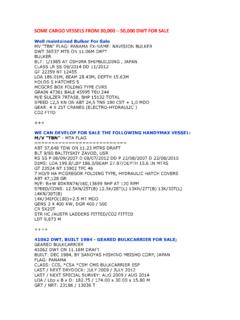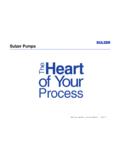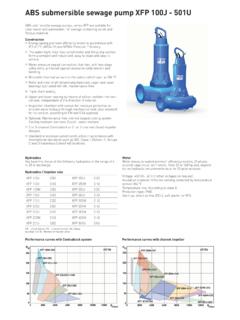Transcription of „Reverse running Pumps as Hydraulic Power …
1 1 Abstract Reverse running Pumps as Hydraulic Power recovery Turbines sulzer design and Experience By Philipp Wildner, , MBA Patrick Welz, Manager Export Sales Head of Tendering Pumps Equipment Pumps Equipment sulzer Pumpen (Deutschland) GmbH sulzer Pumpen (Deutschland) GmbH The concept of reverse running Pumps as Hydraulic Power recovery Turbines (HPRT s) is applied since decades in the industry. Instead of using a pressure reducing valve, the HPRT can be used for throttling the pressure down to suit the following process steps and convert the pressure into rotating shaft energy. sulzer Pumps has years of experience in using reverse running Pumps as turbines as an economical solution to recover energy.
2 The focus of this paper is the selection and design of Expander Trains to be applied in the Hydrocarbon Processing Industry. Main criteria as flow, head, temperature, viscosity, etc. are used to select and design the best reverse running pump. Additionally the other components of an expander train like pump, clutch, lube oil system and motor are covered. Two executed projects including an expander train in a Resid Hydrodesulfurization unit in China (see picture) are presented. 2 Introduction to Hydraulic Power recovery turbines (HPRT) The potential for Power recovery from a high pressure fluid stream exists any time a fluid flows from a high to low pressure and involves a throttling device (valve, orifice, expansion chamber).
3 A HPRT may be used instead of a throttling device to recover (generate) energy. The captured energy may be used to drive a pump, a van a generator or may assist an electric motor to drive any rotating equipment. In a HPRT the direction of flow is reversed compared to a pump the pump suction nozzle becomes the HPRT discharge nozzle and the pump discharge nozzle becomes the HPRT suction nozzle. The selection and design of a HPRT is quite similar to the selection and design of a pump. Differential head, flow, density, viscosity and temperature are the governing parameters to select and design a HPRT. All centrifugal Pumps from low to high specific speed, whether single or multistage, horizontal or vertical, can be operated in reverse and used as a HPRT.
4 High specific speed Pumps (axial flow) are used for lower head und higher flow, single stage or multi stage radial flow Pumps are used for higher heads and lower flow. Due to the reversed direction of flow some small modifications to the Hydraulic channels of a HPRT are required: The shrouds and vane tips are rounded since flow enters and not exits at those locations. Where and when can we use a HPRT. In all processes where pressure needs to be throttled to suit the subsequent process steps a HPRT can be used. The advantage of using a HPRT instead of a throttling device (valve, orifice, expansion chamber) is, that energy will be captured instead of wasted.
5 Typical applications for HPRTs are: Natural Gas Treating (to remove H2S & CO2) Hydrotreating in a refinery, Potassium Carbonate Service in a Fertilizer Plant Hydroelectric Power plants. 3 Potential issues Nearly all HPRT installations in gas plants, refineries and petrochemical plants involve a process that has gas or vapor in the fluid (CO2, H2S, C4, etc.). When the pressure decreases across the HPRT, the gas starts to come out of solution. HPRT inlet pressures are often above critical pressure of any gas present such as methane, ethane, CO2 or H2S. As such, there may be no "free gas" present at the inlet. No gas, or a seemingly tiny percentage by weight of gas at the inlet (less than 1/10th percent) can be a substantial volume percentage at exhaust pressure.
6 This can result in vibrations caused by bubbles and cause seizures and mechanical seal failures. Furthermore, high gas volume at HPRT outlet can accelerate the HPRT a speed (run away speed) which is several times the rated speed if the HPRT is uncoupled . Gas is especially bad for mechanical seals that are designed for liquid sealing. To avoid shortening of mechanical seal life, Annex C of API recommends the use of Seal flush system from another source than HPRT Inlet ( Plan 32, 54). This also helps to avoid gas pockets in the mechanical seal chamber. Special consideration has to be paid to the maximum back pressure of the HPRT. It must be less than MAWP of HPRT exhaust region, seal chamber and mechanical seals.
7 Annex C of API 610 recommends a pressure relief valve to be installed upstream of backpressure control valve to protect HPRT if backpressure control valve is closed. sulzer builds a number of multistage HPRT's with opposed impellers. API 610 BB3 type MSD pump, BB5 type volute CP pump or diffuser type GSG pump. For multistage HPRT's, opposed impeller rotor construction is preferred due to the fact that in such "back-to-back" rotors, if there is fluid at the HPRT inlet, there is fluid on the center bushing. That results in rotor stability under adverse Exhaust situations. sulzer API 610 BB3 pump MSD sulzer API 610 BB5 volute type pump CP sulzer API 610 BB5 diffusor type pump GSG The HPRT as part of a complete pump train If the HPRT is used to support the driver (electric motor) of a pump (dual drivers), Annex C of API 610 recommends the use of an overrunning clutch.
8 An overrunning clutch (that is, a clutch that transmits torque in one direction and freewheels in the other) should generally be used between the HPRT and the train. This allows the driven equipment to operate during HPRT maintenance and also allows to start-up of the train before the HPRT process stream is lined up. A further reason for using an overrunning clutch is that if the flow drops to about 40 % of the rated flow, the HPRT stops producing Power but consumes Power . An overrunning clutch will prevent this. In any case the main driver should have a Power rating to drive the train without assistance from the HPRT. 4 HPRT testing Testing of HPRT's requires a pump to pressurize the fluid to drive the HPRT.
9 Hence testing of HPRTs is more complex and time consuming than testing of a pump. The performance test tolerances for HPRTs are specified in API 610, Annex C. Pump criteria for performance testing given in the API are not applicable for HPRT s. The rated head to be achieved must be within +/- 5% of rated flow, the rated Power to be achieved must be within +/- 5% of rated flow. Vibration criteria for HPRT s are the same as for Pumps specified in the API. A typical set up for a HPRT performance test at sulzer s test bed is shown in below picture. To prove the integrity of the complete pump train, sulzer performes complete unit tests in the following arrangement.
10 5 Example of sulzer HPRT s sulzer has already supplied hundreds of HPRT s in different applications. The following example describes a sulzer HPRT train installed in a chinese Resid Hydrodesulfurization Unit. The HPRT is supporting the electric motor of a Reaction Charge Pump. For the pump, sulzer selected a GSG 150-360 / 6+6 (API BB5, diffusor type barrel pump). The HPRT is a sulzer GSG 100-300 / 6+6 (API BB5, diffusor type barrel pump). The electric motor is installed between the pump and the HPRT, the HPRT is connected to the motor via an overrunning clutch. For the pump API Plan 23 + 52 seal flush piping is applied. For the HPRT Plan 32 + 53C seal flush piping is applied.




